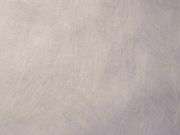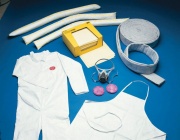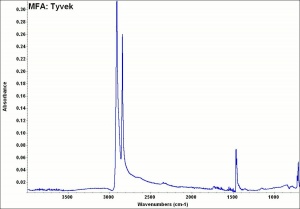Difference between revisions of "Tyvek"
| Line 11: | Line 11: | ||
== Properties == | == Properties == | ||
| − | Resistant to acids, alkalis and most organic solvents. Fibers are 0.5-10 microns. Chemical resistant. Neutral pH. Waterproof, acid-free, lint-free, resistant to mold, mildew, and insects. Shrinks at 118 <sup>o</sup>C. Melting point = 135 <sup>o</sup>C. Maintains toughness and flexibility down to -73 <sup>o</sup>C. | + | Resistant to acids, alkalis and most organic solvents. Fibers are 0.5-10 microns. Chemical resistant. Neutral pH. Waterproof, acid-free, lint-free, resistant to mold, mildew, and insects. |
| + | Shrinks at 118 <sup>o</sup>C. Melting point = 135 <sup>o</sup>C. Maintains toughness and flexibility down to -73 <sup>o</sup>C. | ||
Dimensional stability depends on fiber thickness. Lighter weights may elongate up to 25% before breaking. | Dimensional stability depends on fiber thickness. Lighter weights may elongate up to 25% before breaking. | ||
Revision as of 18:35, 4 November 2018
Description
[DuPont] Discovered in 1955, this spunbonded, olefin product was trademarked in 1967. Tyvek is 100% High density polyethylene without any fillers or binders. The fine, white, continuous filaments (0.5-10 microns) are bonded by heat and pressure to form a dimensionally stable, opaque sheet. Tyvek is chemically stable, lightweight, durable, strong, lint-free, and acid-free. The paper/fabric is resistant to wetting, but it allows transmission of moisture and vapors. It is widely used as a wear resistant, tear resistant, waterproof paper for banners, maps, and envelopes. Applications also include filtration, packaging, bookcovers, interleaving, clean room clothing, protective garments, and carpet backing. Tyvek is commonly seen as a protective barrier in new housing construction. In museums, the high-strength wrapping material is used a soft, lint-free, waterproof liner in packing crates and display cases. It is available in stiff (Type 10), soft (Type 14) and perforated (Type 16) forms (PACCIN).
Synonyms and Related Terms
Tyvek@; Tyvek Hardwrap; Tyvek Softwrap; Crate liner
Properties
Resistant to acids, alkalis and most organic solvents. Fibers are 0.5-10 microns. Chemical resistant. Neutral pH. Waterproof, acid-free, lint-free, resistant to mold, mildew, and insects. Shrinks at 118 oC. Melting point = 135 oC. Maintains toughness and flexibility down to -73 oC.
Dimensional stability depends on fiber thickness. Lighter weights may elongate up to 25% before breaking.
Hazards and Safety
Degraded by Freon, Pine oil, turpentine, Dichloromethane, Mineral spirits, Ligroin, Kerosene, Toluene.
Tyvek is degraded by direct exposure to sunlight. Tyvek may generate static electricity unless treated with antistatic agents.
Handling and Workability
Type 10= paper-like, hard structure, area-bonded, smooth pattern, stiff
Type 14= fabric-like, soft structure, point-bonded, embossed pattern, flexible
Tyvek is tear resistant but is easily cut with scissors or a knife. Water vapor can pass Tyvek, but liquid water cannot.
Tyvek can be bonded by ultrasonic welding or dielectric bonding. Heat sealing causes puckering as it often bonds to itself. Dupont recommends water-based adhesives (starch, dextrin, animal glues, PVAC) over any synthetic solvent-based adhesives.
Forms and Sizes
Tyvek sheets are available as 30", 36” and 60” wide rolls in length up to 100 yds long. Thicknesses can range from 6.6 mils (1025=hard, 1443R=soft), 7.3 mills (1020=hard) and 7.6 mils (14M=soft)
Various sizes of pre-made folders, media sleeves, envelopes and expansion envelopes.
Applications for Storage Exhibit and Transport
- Support for textiles
- Non-abrasive, tear-resistant envelopes and media sleeves
- Moisture proof liner for cases and crates
- Cover foam pads or line cavities in contour cut foam
- Light-blocking and form-fitting dust covers
- Soft Tyvek used to make filled bags/snakes to stabilize objects during transport
Additional Information
DuPont: Tyvek Website
Sources Checked for Data in Record
- Preparation, Art Handling, Collections Care Information Network (PACCIN)
- Rosalie Rosso King, Rosalie Rosso King, Textile Identification, Conservation, and Preservation, Noyes Publications, Park Ridge, NJ, 1985
- Book and Paper Group, Book and Paper Group, Paper Conservation Catalog, AIC, 1984, 1989
- Pam Hatchfield, Pam Hatchfield, Pollutants in the Museum Environment, Archetype Press, London, 2002
- Meredith Montague, Meredith Montague, contributed information, 1998
- Website address 1, Website address 1 Comment: AMOL reCollections Glossary -http://amol.org.au/recollections/7/c/htm


